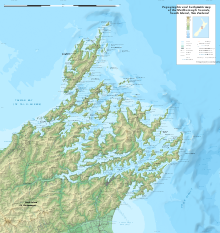TheMarlborough Sounds(te reo Māori:Te Tauihu-o-te-Waka) are an extensive network ofsea-drowned valleysat the northern end of theSouth Islandof New Zealand. The Marlborough Sounds were created by a combination ofland subsidenceandrising sea levels.[1]According toMāori mythology,the sounds are theprowsof the many sunkenwakaofAoraki.[2]



Overview
editCovering some 4,000 km2(1,500 sq mi) of sounds, islands, and peninsulas, the Marlborough Sounds lie at the South Island's north-easternmost point, betweenTasman Bayin the west andCloudy Bayin the south-east. The almostfractalcoastline has 1/10 of the length of New Zealand's coasts.[3]
The steep, wooded hills and small quiet bays of the sounds are sparsely populated, as access is difficult. Many of the small settlements and isolated houses are only accessible by boat. The main large port isPictonon the mainland, at the head ofQueen Charlotte Sound.It is at the northern terminus of the South Island's main railway andstate highwaynetworks. The main small-boat port,Waikawa,is one of New Zealand's largest and provides a base for leisure sailors and vacationers.
The main sounds, other than Queen Charlotte Sound, arePelorus Sound / Te HoiereandKenepuru Sound.Havelockis a small port town at the head ofPelorus Sound / Te Hoiere.Tory Channelis a major arm of Queen Charlotte Sound, and between them, the Channel and the Sound isolate the hills ofArapaoa Islandfrom the mainland. Other major islands in the sounds includeD'Urville Island.
The Sounds are home to the entire breeding population of the rare andvulnerablerough-faced shag(also known as the New Zealand king cormorant) which nests on asmall number of rocky isletsthere.[4]TheDepartment of Conservationmanages a total of over 50 reserves in the area.[2]
History
editPre-modern era
editThe sounds were extensively travelled and partly inhabited byMāorigroups before the coming of the Europeans, using the sounds as shelter from bad weather and partaking of the rich food sources. Māori were also known to carry their canoes over some stretches of land onportagepaths.[2]However, as in most areas of the South Island, populations were smaller than in the North Island.
European history of the area is considered to start withCaptain Cook's visit to the sounds in the 1770s, discovering a plant (Cook's scurvy grass) high invitamin Cwhich helped to curescurvyamongst his crew. OnMotuara Island,Cook also proclaimed British sovereignty over the South Island.[2]Some parts of the sounds also later developed a significantwhalinghistory,[2]and much of the sounds was (thinly) settled by European farmers in the late 19th and early 20th century.[citation needed]
Ferries and marine farms
editThe Marlborough Sounds are connected toCook Straitat the north-east extreme. At this point, theNorth Islandis at its closest to the South Island, and the inter-island road, rail, and passengerferryservice between Picton andWellingtontravels through the sounds.
Marine farming, especially ofsalmonandmussels,is increasingly common, having started in the 1960s.[5]However, thewakescaused by fastcatamaranvehicular ferry services to the North Island have allegedly damaged farms and destroyedcrabgrounds. They were also blamed for stripping the local beaches bare of sand, and damaging landings and other facilities built close to the water's edge. This resulted in a dispute heard in the New ZealandEnvironment Courtin the early 1990s, brought forward by the 'Guardians of the Sounds' group. The court, however, not only refused to restrict the fast ferries but also awarded NZ$300,000 in court costs against the citizen group which had brought the case. This was seen as a strong blow against civic action, and a curtailing of the powers of theResource Management Act.
However, as damage increasingly became visible, and protests continued, the fast ferries (which only operated for the summer season) were eventually restricted to a lower speed of 18 knots in the sounds (officially for safety reasons), reducing their time advantage over the conventional ferries.[6]They have since been discontinued.
In July/August 2007, the 'Guardians of the Sounds' environmentalist group planned a 100-ship flotilla protest againstscallop dredgingin the sounds, which they consider damages the ecosystem of the sounds similar tobottom trawlingin the open sea. The protest was intended to call attention to what they allege is the Ministry of Fisheries ignoring the detrimental effect of the practice. Commercial scallops harvesting companies have warned that protests could endanger lives if the protesters engaged in dangerous manoeuvres, while the Ministry of Fisheries has also noted that only 6% of the sounds are set aside for the dredging, though this had been much more extensive in the past.[7]
Dangerous waters
editThe main channels of the Marlborough Sounds have calm water and are popular forsailing.Cook Strait,however, is infamous for its strong currents and rough waters, especially when the wind is from the south or north. Because of this, some of the narrow channels closer to the Strait are dangerous to navigate. Notable amongst these isFrench Passat the southern end of D'Urville Island, which has severalvortices.
The most notable shipwreck in the sounds is that of the Russian cruise linerMSMikhail Lermontov,which sank in 1986 inPort Gore,close to the mouth of Queen Charlotte Sound, after colliding with rocks. One crew member was killed in the disaster. The ship herself is now a populardive wreck.
References
edit- ^Rocky coasts(from theTe Ara: The Encyclopedia of New Zealand)
- ^abcde Marlborough SoundsArchived2008-10-15 at theWayback Machine(from theDepartment of Conservationwebsite. Accessed 2008-05-16.)
- ^A Nicol (2011).Landscape history of the Marlborough Sounds, New Zealand,New Zealand Journal of Geology and Geophysics, 54:2, 195–208,doi:10.1080/00288306.2010.523079
- ^BirdLife International. (2012).Important Bird Areas factsheets: Duffers Reef. Sentinel Rock. Trio Islands. White Rocks.Downloaded fromhttp:// birdlife.orgon 2012-02-03.
- ^History of the NZMFANew Zealand Seafood Industry Council
- ^Fast FerriesArchived2007-07-18 at theWayback Machine(from theGuardians of the Soundsaction group website)
- ^Booker, Jarrod (7 July 2007)."100-strong flotilla to stage protest on scallop fishing".The New Zealand Herald.Retrieved20 October2011.